ACROBAT
How to write a resume — a step-by-step guide.
A resume is the first piece of information employers get about you.

How to write a resume in eight simple steps.
Writing a resume can be overwhelming — especially if you’re not sure what to include or how to make it eye-catching. This short guide will help you know where to start and will answer the questions you may have about writing the perfect resume.
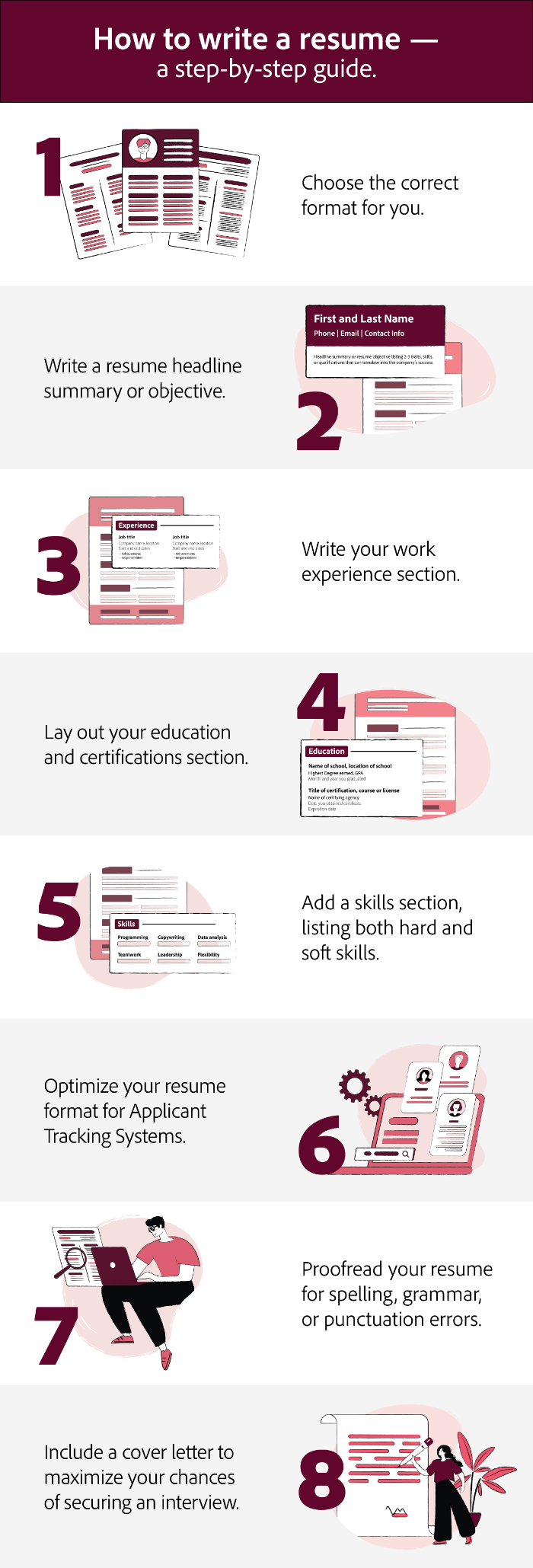
1. Choose the correct resume format for you.
The first thing that you will want to do is to choose the right template and format to summarize your job experience for the specific position you are applying for. There are three standard formats — and although each of them uses the same traditional resume sections, they are organized differently. Learn about the different types and choose the one that emphasizes the skills and experience you want to highlight.
- Chronological resume format. This is the most commonly used format, and it’s ideal for those candidates who want to make their work experience stand out since this section sits front and center. As the standard format, it tends to be the easiest to read and scan. You will list your most recent positions first, and then go back through past jobs in reverse-chronological order.
- Functional resume format. This format highlights your skills and training instead of your work experience and history. This format is usually the best fit for first-time job seekers looking to write a resume with no work experience or for candidates who are changing careers or have employment gaps.
- Combination resume format. This type of resume combines the two previous formats and is great for experienced pros and career changers, as it highlights transferable skills.
If you are not sure what type of resume you want to use, you can seek out some resume template examples online to explore options and what details you should consider including. When you find the one that best fits your needs and interests, you can use a PDF editor to make the necessary changes and make it your own. Depending on the company and position you are applying for, you can choose a more formal or casual style for your template.
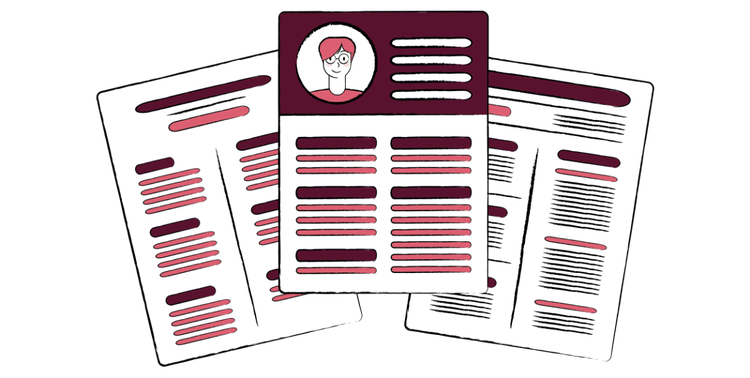
Contact information to include and leave out.
When you submit your resume, you want to make sure the hiring manager has the appropriate information to contact you in case you are selected to move forward in the interview process. However, just like there is contact information you need to include on your resume, there is also certain information you will want to leave out for your resume to be professional and not crowded.
Contact information to include in a resume.
- Name. First name, last name (middle name optional).
- Phone number. You will want to include your personal cell phone number over your home phone number.
- Email address. This is likely how a hiring manager will be reaching out to you to follow up after you apply for a position.
- LinkedIn URL. Although it is common that potential employers may look you up on LinkedIn anyway, it may be useful to include this information on your resume to make their job easier.
Contact information to leave off your resume.
- Second email or phone number. Adding an additional email address or phone number will only make the hiring manager confused when it comes to contacting you for follow up.
- Home address. Unless specified on the job post, you shouldn’t need to include your home address on your resume.
- Photo or headshot. Employers may worry about discrimination lawsuits if you include a headshot on your resume, which may lead to them discarding you as a candidate for the position.
- Date of birth. Unless specified on the job post, you shouldn’t need to include your age on your resume.
Optional sections for your resume.
- Social media handles. With the exception of some cases such as social media manager positions, most employers won’t require you to list your social media handles on your resume.
- Personal website. Unless you are applying for a job that requires the hiring manager to review your portfolio or website, you won’t need to add this to your resume.
- Hobbies and interests. Your hobbies can prove other abilities that may be of interest to potential employers, such as the ability to work well on a team or creative thinking ability. Including a couple hobbies on your resume can also help you stand out and be memorable.
- Volunteer work. For most job seekers, listing any volunteer experience as one of your additional resume sections is a great way to show your commitment and values. This can be especially useful to include for entry-level or first-time applicants who have no experience in the field yet.
- Internship experience. Depending on whether you are fresh out of college, have only had one or two other jobs, or have only been in the job market for four to five years, you can consider listing your internship experience on your resume.
- Certifications and awards. If your certifications, licenses, or awards are relevant to the job and industry you are applying for, you can certainly include them on your resume.
- Languages. Listing language skills on a resume only extends your usefulness as an employee, especially if you are applying for a position in an international company where there is a large population speaking that second language.
- Publications. If you have published work or have written articles for a blog, newspaper, or scientific journal, you can mention those on a resume. This can be especially useful if you’re applying for a writer or editor position.
2. Write a resume headline summary or objective.
A resume headline summary is like your social media bio or a company’s mission statement.
Since recruiters and hiring managers usually spend less than two minutes reviewing a resume, a headline summary is likely one of the first things their eyes will land on, as it is at the top of the page. A resume headline is a brief, impactful phrase that summarizes your professional identity and value. Placed at the top of your resume, it helps recruiters quickly understand who you are and what you bring to the table. Here are sample headlines for different roles:
Marketing
• Data-Driven Digital Marketing Strategist with Proven ROI Results (make this italic)
• SEO Specialist Focused on Organic Growth and Content Optimization (make this italic)
Engineering
• Innovative Mechanical Engineer Specializing in Sustainable Design (make this italic)
• Full-Stack Developer with Expertise in Scalable Web Applications (make this italic)
Entry-Level
• Recent Business Graduate with Internship Experience in Market Research (make this italic)
• Aspiring IT Support Specialist with Hands-On Training in Network Systems (make this italic)
Choose a headline that reflects your strengths and aligns with the role you're targeting. Keep it concise, ideally one line, and tailor it for each application to maximize impact.
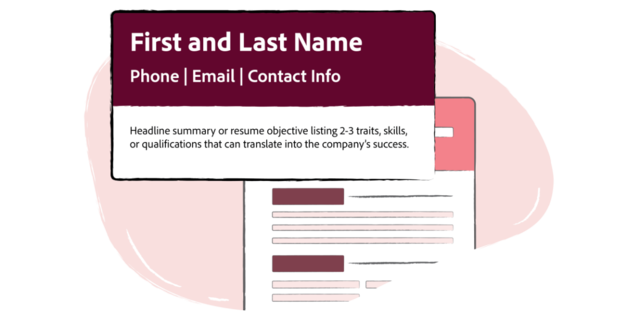
For a headline summary, your goal is to compose a statement that paints an accurate but attractive picture of your candidacy and expertise. Here’s how to write a professional summary for your resume to stand out:
- Place your resume summary under your contact information. The most effective place to put your resume summary is immediately after your name and contact information. This placement ensures that your key accomplishments are right at the top of the resume, where you are most likely to get the full attention of the recruiter.
- Start with a key adjective for yourself. Choose an adjective that describes you and that is directly related to the position you are applying for.
- Provide evidence of your skills and experience. Use active voice and include key action words to describe your experience.
- Keep it brief. There is so much more information left to read for the hiring manager. Your resume summary should not be too detailed but keep the recruiter interested. Give a glimpse of who you are and what makes you stand out. Keep your resume summary short and concise, between two to three sentences.
You can also write a resume objective right under your name and contact information.
Here are a few tips for how to make your resume objective hit home:
- Start by naming two to three traits, skills, or qualifications that can translate into the company’s success.
- Write what you hope to do for the company.
- Mention the job title or position you are seeking and why you want to achieve this job.
- Keep it short, preferably under 50 words.
- Remember to tailor your resume objective to the job offer you are applying for.
3. How to write your work experience section.
This is often the most important section of your resume, the heart of your resume, and the section hiring managers will spend most of their time reading.
The first things a recruiter looks at on your resume are the job titles you’ve held and the companies you’ve worked with. Make this information easy to find by listing each job in reverse-chronological order meaning writing your latest job first. Lastly, remember not to go back more than 10–15 years, although the more experience you have, the less you should worry about the length of your resume.
Career gaps are common and can be framed positively to reflect personal growth, skill development, or life priorities. The key is to be honest, clear, and confident in your explanation. Here are a few ways to format and phrase different types of gaps:
Caregiving
• Career Break for Family Care
January 2022 – August 2023
Provided full-time care for a family member while maintaining professional development through online courses in [industry-relevant topic].
Education
• Full-Time Student
September 2021 – May 2023
Completed [Degree or Certification] at [Institution], focusing on [relevant skills or subjects].
Travel or Sabbatical
• Professional Sabbatical
March 2020 – December 2020
Traveled internationally to gain cross-cultural experience and broaden global perspective; engaged in freelance projects and language study.
By framing gaps with purpose and relevance, you show employers that your time away from traditional employment was intentional and enriching.
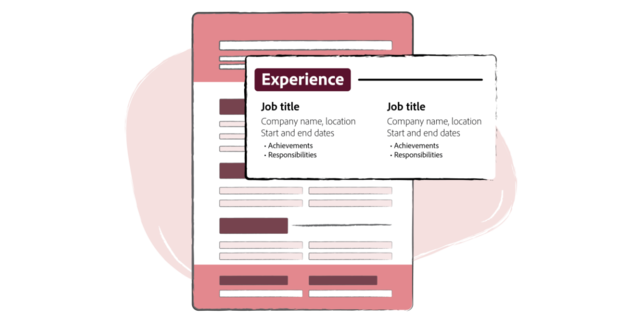
Each job should have its own subheading that includes the following information:
- Company name and location. Include the full name of the company you worked for followed by the city and state of its location.
- Job title. Be as specific as possible to make sure employers know exactly what your role was within the company.
- Start and end dates. Include the month and year for each position.
- Achievements and responsibilities: List the tasks you performed by starting each sentence with action verbs — and using active voice. Write what you accomplished using bullet points. Include hard numbers and metrics wherever possible.
4. What to include in a resume education section.
An education section will be especially helpful and valuable if you have limited work experience or if you’re transferring to a new industry.
You should always include this section, although where it appears depends on your individual circumstances. If you are just starting out in your career, it’s generally a great idea to include your education section near the top of your resume. However, if you’re a few years into your career, your education can appear at the bottom of your resume. This is because your work experience will be more relevant to potential employers at this point in your career. Unless you’re applying to a job where the emphasis is on education — such as academia, law, or medicine — most job seekers will opt for adding this section at the bottom of their resume.
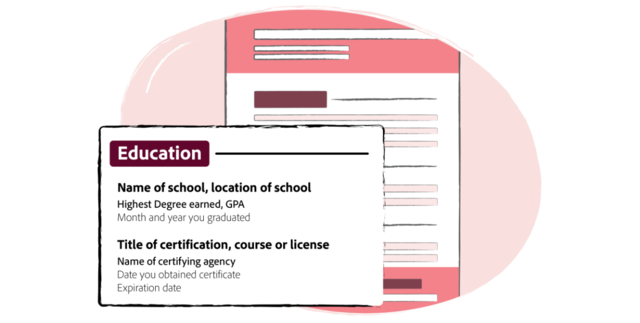
Below you can find what every resume education section must include:
- The name of the university, community college, or school. Put your highest degree first. Only include high school or GED if you’re a high school student or didn’t attend university.
- Location of the school. Write the city and the state.
- The month and year you graduated. If you haven’t graduated yet, then write the expected graduation date.
- The type of degree you received or expect to receive and the program.
- Your GPA. This is good to include if it is higher than 3.5 and you just graduated college or if it’s required. You might also consider adding relevant coursework, honors, scholarships, and recent awards, such as the dean’s list.
How to include certifications, licenses, and training.
Professional certifications are a way to validate your skills and knowledge in a particular area. They can be helpful when you’re looking for a job or trying to move up in your current company. You can list your certifications right under your education information.
To put certifications on your resume, be sure to write the following elements in the order below:
- The title of the certification, course, or license.
- The name of the certifying agency or body.
- The date you obtained each certificate.
- The expiration date of your certificate or, if it is in progress, add the expected date of completion. If the certification is still valid, you can also mention that.
5. Skills to put on a resume.
You can also add a skills section on your resume to mention all the skills and know-how that make you the ideal candidate for the job.
Before you write anything, pay attention to the skills that are listed in the job description of the position you’re applying for. Using these keywords on your resume can greatly increase the chance that your resume will be seen by an actual hiring manager, leading to a job interview.
When doing this, consider both hard technical skills and soft interpersonal skills.
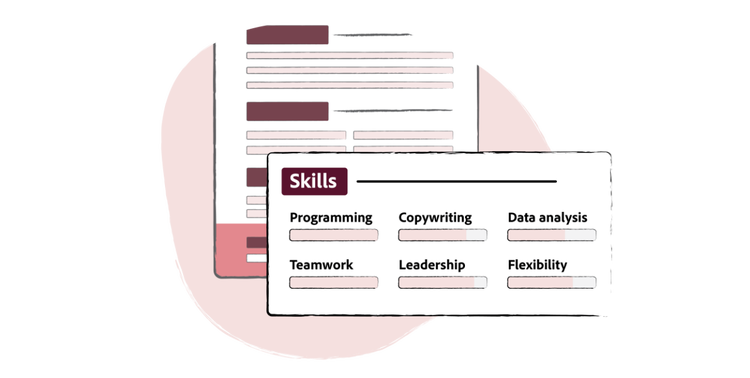
Hard skills vs. soft skills.
Hard skills are the specific skills and knowledge that you need to perform a certain task or job. They are also usually quantifiable and easy to measure. Some examples are:
- Computer programming
- Copywriting
- Data analysis
- Accounting
- Graphic design
- Web development
- SEO
Soft skills are interpersonal skills that help you interact with others. They are more difficult to quantify but just as important in the workplace. Some examples are:
- Communication
- Leadership
- Teamwork
- Problem-solving
- Time management
- Critical thinking
- Self management
- Flexibility
You can use the Adobe Express app to create a resume or explore free resume templates that will best fit your preferences and needs. Adobe Express is the free online resume maker that will help you showcase yourself and your achievements. Using Express is as simple as selecting a template, editing it, and sharing it in any format you choose.
6. Formatting for an ATS-friendly resume.
Formatting your resume correctly is important if you want to get more job interviews. Nowadays, your resume most likely will go straight into Applicant Tracking Systems (ATS), a computer database used to manage high volumes of job applicants. ATS scans your resume, scores your qualifications based on the description for that position, and ranks your application.
If your resume can’t be read by the ATS due to formatting issues, then all your hard work may have been for nothing.
Tips for formatting and organizing your resume.
You can follow these formatting tips for the ATS computer database system to easily read your resume:
- Use language that is simple and easy to understand. Jargon or complex language will only confuse the ATS.
- Use a common font such as Times New Roman, Arial, or Helvetica for optimal readability.
- Use a font size that is easy to read. The recommended size is 11–12 pt for regular text, and 14–16 pt for section titles.
- Make sure that the margins on all sides of your resume are 1 inch so that it doesn’t look too crowded.
- Make sure to proofread your resume for mistakes before you send it off.
- Use bullet points when listing several different pieces of information, like under your education and professional history sections.
- Don’t use special characters or symbols that an ATS might misinterpret.
- Don’t use tables and columns to organize your resume. This can cause important information to get lost when an ATS scans your resume.
As to which format you should use when creating and submitting your resume, PDF can frequently be your best choice for the following reasons:
- PDFs tend to look more professional.
- PDFs are usually easier and less problematic to upload.
- PDFs work with a multitude of software and operating systems.
- PDFs are static and cannot be altered easily, unlike Word documents.
If you’re still wondering whether you should send your resume as a PDF, the answer to this question ultimately depends on your prospective employer’s instructions.
If you don’t already have your resume saved as a PDF file, you can opt for an online tool that enables you to convert Word files to PDFs online.
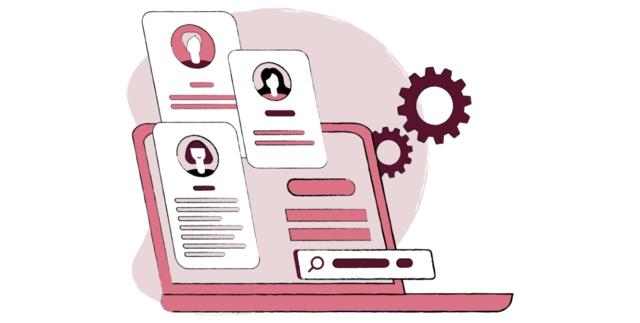
What is the x, y, z method for resume writing?
The x, y, z method for resume writing consists of including in one sentence: what you’ve accomplished (X) + the qualitative results (Y) + the skills or experience you utilized to achieve the outcome (Z).
This is an easy-to-read, concise, and practical way to provide context and flow. This method is useful and important because it helps you hone in on specific achievements so that your hiring manager can find your accomplishments more easily. It also helps work well with ATS, as you will be able to include specific keywords.
To write your resume using the x, y, z method, follow these simple guidelines:
- X. Start with an active verb that helps provide clarity to the reader about what you achieved.
- Y. Describe how the achievement was measured. Use facts, numbers, or figures to help add credibility and insight into your strengths.
- Z. Following this, write how you achieved it — what you did and how you did it — which helps the reader focus on the most relevant experience and results.
An example of the x, y, z method would be:
Reduced business costs and increased profit (X), reducing food costs by 15% (Y) by reviewing purchased items and negotiating with suppliers (Z).
7. Proofread your resume.
Before you submit your resume to your prospective employer, you should review your resume for spelling, grammar, and punctuation errors. You can read your resume backward to notice errors you hadn’t identified before, you can have your friends, colleagues, professors, and family members review it as well, or you can use free online proofreading tools.
If, after writing your resume, you notice that it is more than one page, consider ways to consolidate or shorten each section by removing filler words or extraneous information. Remember to proofread and update your resume before sending it off since it could make all the difference in whether or not you get a job interview.
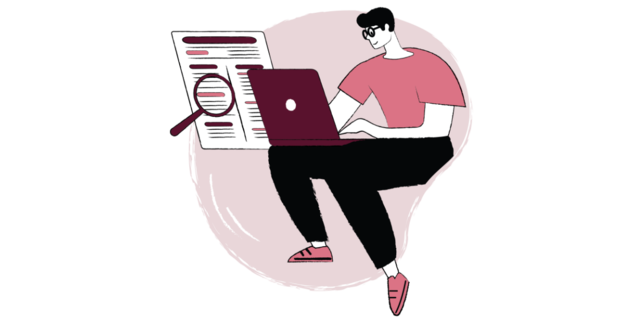
How to tailor your resume to the job.
Different industries value different resume styles, formats, and content. Tailoring your resume to meet those expectations can significantly improve your chances of landing interviews.
1. Creative Fields (Design, Writing, Marketing)
• Use a visually appealing layout that reflects your personal brand.
• Include a portfolio link or samples of work.
• Highlight creative tools (e.g., Adobe Creative Suite, Figma) and campaign results.
2. Technology (Engineering, IT, Data Science)
• Prioritize technical skills and certifications (e.g., AWS, Python, Agile).
• Use bullet points to showcase project outcomes and metrics.
• Include GitHub or project links to demonstrate hands-on experience.
3. Healthcare
• Focus on licenses and certifications (e.g., RN, BLS, CNA).
• Emphasize patient care experience and compliance with regulations.
• Use clear, structured formatting to highlight clinical roles and responsibilities.
4. Education
• List teaching credentials and subject specialties.
• Include classroom management strategies and student outcomes.
• Mention experience with remote learning tools or curriculum development.
5. Entry-Level or Career Change
• Use a strong summary to highlight transferable skills.
• Include volunteer work, internships, or relevant coursework.
• Consider a functional resume format to emphasize skills over chronology.
8. Do I need a cover letter?
Although some job posts and companies may list cover letters as optional, it is often best to include one to maximize your chance of securing an interview.
The purposes of a cover letter are to demonstrate to potential employers that you are interested in the position, explain your unique qualifications, and persuade the hiring manager that you are the best fit.
If you choose to submit a cover letter along with your resume, consider adding a greeting, an opening, the body, a closing, and making sure it is not longer than one page.
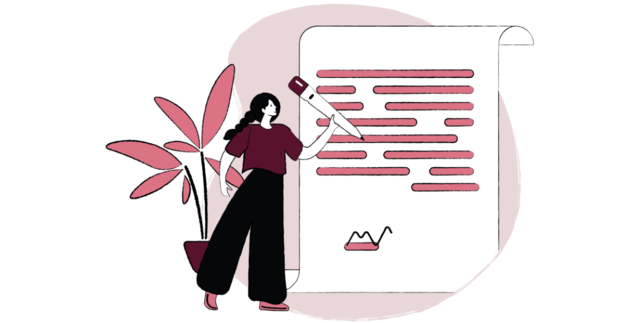
Frequently asked questions.
How long should a resume be?
While most employers typically consider it best to stick with one-page resumes, they’re not the best for every situation.
If you have tons of experience and achievements that relate directly to the position you’re applying for, you might want to make sure the hiring manager sees every impressive detail. In this case, it’s okay to go onto two or even three pages.
However, before working on that third page of accomplishments, make sure everything you add is completely relevant and impressive. Only include information that will set you apart from the other applicants or that emphasizes your qualifications for that particular position. Most multi-page resumes are for jobs that require 10 or more years of experience, like manager, executive, or other high-level positions.
Recruiters and hiring managers have spoken about this issue, and most of them agree that they won’t really look at a resume that is longer than one page. In fact, a great deal of them spend less than a minute reviewing a resume. If you are just fresh out of college, you will want to make sure your resume is the appropriate length, meaning not longer than one page.
That said, you should also strive to make your one-page resume not crowded but still include enough information to fill the page.
Should I include personal interests on my resume?
If you have the space and you think your personal interests are relevant information for the position you are applying for, it can be a good idea to include them to make your resume stand out and be more personalized. These personal interests or hobbies can help you stand out and be memorable to the hiring managers, as well as say something about you that is not included in your job experience.
How do I address any gaps in employment?
Whether the reason for your gaps in employment were raising your children, going back to school, or traveling, you will most likely need to explain why there is a gap on your resume. Without explaining gaps in employment, a recruiter may assume the worst. To address a gap, simply state in two lines or less that you were doing during that time. You can share the value you picked up along the way by including a list of qualities you learned from that time. Above all, don’t try to hide your employment gap, assume that the hiring manager will find it and get ahead of the game by addressing it briefly.
How do you write a good resume?
Make sure you proofread your resume before you submit it or send it to the hiring manager. A typo or misspelled word can make you come across as unprofessional or not detail-oriented and could potentially cost you the job. You should also update your resume every time you are applying for a new job to include your latest position and accomplishments. You can do this manually, or use a resume writing AI tool to easily keep it up to date and improve it over time.
